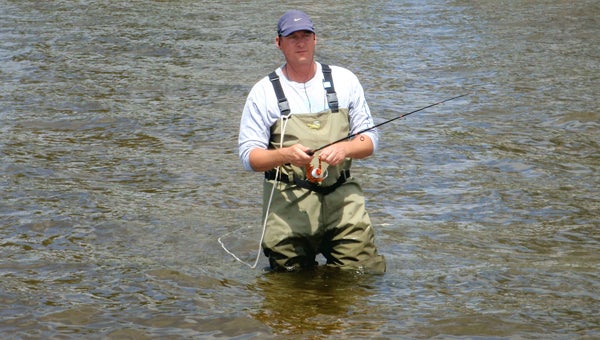Small speckled trout delicate but numerous in our waters
Published 11:40 am Monday, October 12, 2015

FRED BONNER | CONTRIBUTED
CASTING A LINE: This wade fishing angler is hoping to catch some “keeper” speckled trout, but this year’s crop of specks looks like they need to grow a little. Wade fishing in the Pamlico River’s shallow water is a good way to catch these fall run fish as they chase small shrimp and minnows in the shallows.
Virtually every fishing report that I hear from anglers who specialize in fishing for speckled trout is the same: We caught lots of ‘specs,’ but hardly a single one of them was 14 inches long. These discouraged fishermen should take heart! Those 1-year-old baby trout are the hope for future years in our area.
Last year’s harsh freezes on the Pamlico River killed speckled trout by the thousands and these trout were well over the 14-inch minimum-size limit. It seems like we have too many of these cold-induced fish kills and, for the speckled trout angler, that’s particularly discouraging. That was the bad news.
The good news is that we’ve had a really good year in our area for aquatic grasses like the eel grass beds we saw along the mouth of the river this summer. These grassy areas are often distained by fishermen who find that their lures frequently snagged on the vegetation, but those grass beds are a great nursery area for the developing young speckled trout. It’s part of their chosen habitat and a necessary part of their survival instincts.
Biologists who took samples of fishes from these patches of aquatic vegetation in the early spring and summer usually found a great number of young speckled trout in their seines. Early in the summer, these trout fed on grass shrimp, plankton, other juvenile fish like silverside minnows, and juvenile blue crabs. With a good summer’s diet in those grass beds, these springtime specs that measured two or three inches long are probably the same 12 to 13 inch specs that fisherman are taking so many of this fall. They’re the hope of the future for speckled trout fishermen.
Speckled trout are able to spawn after they reach their first year and by early next spring, these year-old trout will begin to spawn. What’s even better, the speckled trout don’t spawn just one time a year. They spawn multiple times and as these fish grow even larger, those female fish are capable of producing a million or more fertile eggs. They keep the male speckled trout pretty busy in the spring. Even a 1 percent survival rate of the fertilized eggs is a good “hatch.”
With the minimum size limit on speckled trout in our inland and coastal waters set at 14 inches and the creel limit set at four fish per angler per day, it’s really important to safely release every undersized speckled trout that you take. It may take a little special handling and careful lure selection to help these just a little over a year old fish alive to spawn again another day.
Speckled trout fishermen sometime happen into large schools of these 1-year-plus aged fish and can take (catch) them on about every cast. If you’re casting a lure with treble hooks, it often makes a real mess inside those soft mouths of those young fish. If they’re as hungry as they seem to be at his time of the year, it might be a good idea to put those treble hooked lures back in the box and tie on a grub type lure with a single hook on it. Since you’re going to release those sub-14 inchers anyway, try and release them with as little handling and hook damage as possible. If you really want to help those fish survive until next year, bend the barb down on the single-hooked lure.
Remembering the sharp little teeth on these little speckled trout, leave the fish in the water if possible and try and grab the head of the lure and try to shake the lure free. If you can do this with as little actual handling as you can, the fish should survive to be caught another day.
Speckled trout have been documented as living up to 10 years of age and the Texas record for speckled trout stands at over 14 pounds. Our North Carolina State Record for a speckled trout weighed 12-pounds, 4-ounces and was taken in 1961 by angler John Kenyon near Wrightsville Beach.





